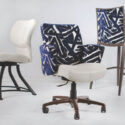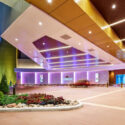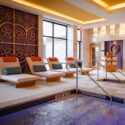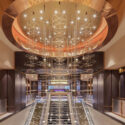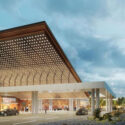
Purchasing Management International (PMI) is a global sourcing and procurement company providing furniture, fixtures and equipment (FF&E) and operating supplies and equipment (OS&E) for the gaming industry. We’re often asked about product durability when we’re working on new construction and renovations of casinos and event centers.
This question centers around owners’ desire to maximize the useful life of these products and get the biggest return on their investment. Most owners have an FF&E capex cycle for their properties, with major milestones related to the main FF&E product categories: case goods, seating, lighting, carpet and soft goods.
Generally, that cycle operates in five-year, seven-year and 10-year periods. Managing the cycle starts with the sourcing strategy, and should be guided by four main topics: use, value, availability and aesthetics.
Use
As we evaluate the use of a product in a casino setting, many things affect the life cycle: the type of product, location in the property (guest room versus casino floor versus restaurant), clientele and the ease of cleaning.
For products like carpet, construction (Axminster versus tufted) and the specific setting can drastically impact usable life. We were recently talking with a major casino company with an expectation of useful life of carpet between seven and 15 years. That client has a very clear program of cleaning and maintenance and also puts carpet in the appropriate location to preserve its useful life.
If the carpet is installed in the wrong location for its intended purpose, it will wear out quickly. If it’s not maintained according to manufacturer instructions, it will wear out more quickly than expected and likely void any warranties.
Seating is used in many different locations throughout a property, and its usable life is generally assumed to be between five and seven years. Owners should consider the clientele and the way they will use slot stools or desk chairs and sofas in the guest rooms. One major casino company accomplishes this goal by using a “sit test” for every chair it puts in its properties. This has many benefits, including confirming that the product is comfortable and will fit many body types.
This client also requires that all products are made to contract quality standards for use in a casino setting. It doesn’t allow seating products purchased from online retailers to be used in its properties.
The location of FF&E in the property also affects the useful life of products. A barstool in a high-limit lounge at a luxury resort will have different usage than a dining chair at a three-meal restaurant in a small casino in a secondary market.
This means that when designing the product, owners need to consider design aspects specific to contract usage, such as the use of stretchers, contract-quality glides appropriate for the floor type, and foam suitable for high-usage environments.
The fabric on the seating should also be durable and stain-resistant. These attributes should be tested with the intended location considered and simulated. Have multiple-sized people sit in, lean back in, even stand on the seat to identify any potential problems that may shorten the life of a product. Ask them to slide across a floor in the seat. That investment in front-end decision-making bears fruit, leading to the longer life of the product.
The product that goes into guest rooms has a very different usage pattern than those used in public spaces, and often makes up the bulk of an investment in the hotel portion of a new construction or renovation project.
The furniture must be at the same time comfortable, affordable and very durable. Case goods should be tested against rough use and for moisture resistance, along with design conformance. I attended a model room review where after the design had been confirmed and everyone agreed they loved the way the room looked, a casino executive attacked case goods with a car key, like a disgruntled guest, to see how it would hold up under severe abuse. He then left several ice-filled glasses on the tops of the various case pieces he had attacked and asked us all to come back the next day to complete the review. He wanted to test how the materials and finishes would hold up in the guest room under usage he had witnessed at his property. This type of review may sound extreme, but resulted in changing some of the materials specified in the case goods because the owner knew how the furniture would be treated in the location it was going to be placed.
The cleanability of FF&E in a casino also impacts the useful life of that product. If guests perceive that a product is dirty—or if in fact it’s dirty because it is difficult to clean—that product will negatively impact the performance of a property. No one likes to sit at dirty tables in sticky chairs. No one likes to have a room lit through a smoke-stained, fingerprint-filled lampshade. Rubbed-off finishes on light fixtures or chairs quickly diminish the perceived level of luxury and make an entire property look tired.
If a product can’t be cleaned effectively or if cleaning damages that product, its useful life is shortened. The difficulty of cleaning a product also impacts the casino employees’ ability to perform. If a housekeeper can effectively clean a room and turn it back more quickly because the materials are easily cleaned with regular cleaning products and normal effort, that increases housekeeping efficiency and in turn increases profitability.
The same holds true for the engineering department. If products can be easily refinished and maintained, the engineering staff will be able to keep a property at like-new status for longer.
Value
When considering the value of a product relative to its useful life, owners should look at the initial purchase cost versus the disruption to operations that a product would cause if it had to be replaced before it was planned.
Maximizing the value of the purchase is a combination of finding the right product in the correct setting and getting as much use out of it as possible. A low initial purchase price may not be the best long-term decision for an owner in a high-use environment like a casino.
Owners should evaluate different aspects of the product when looking at its overall value. If the product is mission-critical (like slot stools), then the extra expense for a better-quality product that lasts longer may be worth the additional cost.
Another consideration relative to value is the overall cost of the product. Replacing meeting-space chandeliers is a very different financial decision than replacing lampshades in guestrooms. The lampshades will have an impact on all guests and may be more valuable to the guest experience.
Availability
The availability of the product and replacement parts also is part of evaluating the useful life of a product.
If the product is easily replaced at a low cost, both operationally and from a cash perspective, typically the useful life is much shorter; take the lampshade example above.
For products that are more difficult to replace, like custom fabric on a barstool, then expectation of a usable life is longer. The availability of certain products informs an owner’s decision for holding attic stock and their sourcing strategy.
If an owner implements a sourcing strategy to purchase from sources where product is easily obtained and production minimums are low, they mitigate their delivery risk and can likely extend the useful life easily because replacement parts are easily obtained. If an owner doesn’t have product that is easily obtained, then the best way to extend the useful life of certain products is to maintain a large supply of attic stock.
Attic stock of full pieces requires large storage areas and is often not feasible, so attic stock can be made up of component parts of product. When FF&E is initially purchased for a new construction or renovation project, owners should purchase component parts of furniture and lighting that the property’s engineering staff can use for repair and replacement.
For furniture and lighting, those items typically include door and drawer hardware, lampshades, finials, power harnesses, casters, drawer glides, drawers and door panels. The property should also purchase roll goods of fabrics used on the property. That includes drapery fabrics, upholstery fabrics, carpets and wall coverings.
Aesthetics
Casinos act as a laboratory for what’s next in hospitality design and guest experience, and are at the forefront of design innovation. This means that products may fall out of fashion or “ugly out” before they wear out.
If a property is well-maintained, it’s a testament to the housekeeping and engineering staff that it looks dated rather than falling apart. The options available to an owner who has a dated-looking property are easier to make because the starting point for a renovation is better. The full-scale renovation of a property is an opportunity to reset a design direction and restart the clock on the product life cycle.
Because good design has a subjective component, working with a qualified interior designer that writes buyable, biddable specifications that consider an owner’s expected usable life along with design aesthetics is the best route to maximizing the shelf life of a design and product.
At PMI, we perform capex studies and budget projections for owners to help with planning and financing for FF&E replacement. That type of study is a powerful tool for executives wanting to stay ahead of their property’s useful life.
Owners can use a capex replacement schedule to give their property management time to plan for displacement of property activities, coordinate design activities, and source and procure all of the product in a predictable method.
In the planning, development and renovation of casinos, smart owners understand that the usable life of the FF&E in their properties directly impacts their bottom line. They can make smart sourcing and purchasing decisions at the start of a project to extend that usable life and develop a detailed capex plan to keep their properties fresh.



